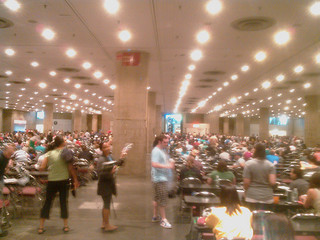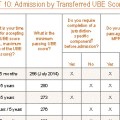 The Uniform Bar Exam (UBE) is simply a typical bar exam that has been standardized for use across numerous jurisdictions.
The Uniform Bar Exam (UBE) is simply a typical bar exam that has been standardized for use across numerous jurisdictions.
This post provides a brief introduction to the UBE, and then discusses each of the three sections of the UBE in detail.
According to the National Conference of Bar Examiners, the UBE is currently administered in 13 jurisdictions: Alabama, Arizona, Colorado, Idaho, Minnesota, Missouri, Montana, Nebraska, New Hampshire, North Dakota, Utah, Washington, and Wyoming.
What is really interesting is that you can transfer your UBE score from one UBE jurisdiction to another. This could be very helpful for people who relocate to another state, giving them the ability to continue working without have to re-take a bar exam.
Sections of the UBE
The UBE consists of the:
- Multistate Bar Examination (MBE);
- Multistate Essay Examination (MEE); and
- Multistate Performance Test (MPT)
In addition, some jurisdictions may test applicants on jurisdiction-specific topics, so be sure to check with the board of bar examiners in your jurisdiction.
The first day of the UBE consists of six, 30-minute essays in the morning (the MEE), followed by two, 90-minute performance tests in the afternoon (the MPT). The second day of the UBE consists of the MBE: 200 multiple choice questions (100 in the morning; 100 in the afternoon), administered over a full day.
Grading the UBE
The grading breakdown is 50% for the MBE, 30% for the MEE, and 20% for the MPT.
Of note is that the MBE is graded nationally, but the MEE and MPT are graded only against other test takers within each jurisdiction.
Therefore, while it will help to practice using sample MEE/MPT questions and score sheets provided by the National Board of Bar Examiners, it would be more helpful to obtain actual graded essays from your jurisdiction, if possible.
Also, each jurisdiction sets its own passing score.
The Multistate Essay Examination
According to the National Conference of Bar Examiners, the purpose of the MEE is to:
- identify legal issues raised by a hypothetical factual situation;
- separate material which is relevant from that which is not;
- present a reasoned analysis of the relevant issues in a clear, concise, and well-organized composition; and
- demonstrate an understanding of the fundamental legal principles relevant to the probable solution of the issues raised by the factual situation.
The MEE gives you three hours to write six essays, which means that you should budget 30 minutes for each essay. This is not a lot of time, so you should be practicing getting your timing down.
When I took the Oregon bar exam, we had to write nine, 30-minute essays. [The Oregon bar now uses the MEE.] The most difficult part for me was being able to write about every issue in 30 minutes. You have to “get in and get out.”
This means that issue spotting and thorough but not over-blown analysis are essential for doing well on this exam. [This is in contrast to a jurisdiction like California where you have 1 hour for each essay and would be expected to either spot many more issues or delve more deeply into some of them.]
Here are some examples of MEE questions and answer analysis (see sidebar on linked page).
NOTE: The answer analysis provided with these samples are not actual bar exam answers. They are written so that the grader can review and see what issues the MEE writers were evaluating. These analyses cite to cases and code sections, but this is not something expected on the bar exam. In short, don’t freak out, but get some sample answers from your bar prep program.
The MEE tests you on 13 subjects:
- Business Associations;
- Conflict of Laws;
- Constitutional Law;
- Contracts (including UCC Article 2);
- Criminal Law;
- Criminal Procedure;
- Evidence;
- Family Law;
- Federal Civil Procedure;
- Real Property;
- Torts;
- Trusts and Estates; and
- Uniform Commercial Code [selected sections]
You can get brief subject matter outlines here in PDF.
Essay writing resources:
- Rigos Primer Series Uniform Bar Exam (UBE) Review Series Multistate Essay Exam MEE Bar Exam
- Rigos Multistate Essay Exam (Rigos Bar Review Series)
- How to Write Bar Exam Essays, available on Amazon, BN, Audible and iTunes.
The Multistate Performance Test
The MPT consists of two, 90-minute performance tests. The National Conference of Bar Examiners says that the purpose of the MPT is to “test an examinee’s ability to use fundamental lawyering skills in a realistic situation. Each test evaluates an examinee’s ability to complete a task that a beginning lawyer should be able to accomplish.”
This means that you will have to read an assignment memorandum, understand what is being asked of you, then sift through some information (e.g., case law, statutes, letters, pleadings, etc.) and decide what is relevant to completion of your task. Then, you will complete the task, which could be a memorandum, letter to a client, a pleading, etc.
Here is something very important to keep in mind: Not all of the information you are given is relevant or accurate. This is intentional, and is designed to test your ability to use critical thought to create the best work product. As explained on the NCBEX website:
Relevant as well as irrelevant facts are included. Facts are sometimes ambiguous, incomplete, or even conflicting. As in practice, a client’s or a supervising attorney’s version of events may be incomplete or unreliable. Examinees are expected to recognize when facts are inconsistent or missing and are expected to identify sources of additional facts.
The UBE requires that you write the two performance tests back-to-back during a single afternoon.
Be sure to practice completing each PT within 90 minutes. This can be quite difficult when you first start, especially if you have not been working as a law clerk and been doing performance-test-like tasks at work.
Here are some free sample MPTs.
Other MPT resources:
- Perform Your Best on the Bar Exam Performance Test (MPT): Train to Finish the MPT in 90 Minutes, Like a Sport(TM)
- Rigos Multistate Performance Test (Rigos Bar Review Series)
The Multistate Bar Examination
The NCBEX states that the purpose of this multiple choice question marathon is “to assess the extent to which an examinee can apply fundamental legal principles and legal reasoning to analyze given fact patterns.”
The MBE consists of 200 multiple choice questions, only 190 of which are graded, with the other 10 questions being experimental questions. Currenlty, the 190 questions are distributed as follows: Constitutional Law (31), Contracts (33), Criminal Law and Procedure (31), Evidence (31), Real Property (31), and Torts (33). [Beginning in February 2015, federal civil procedure will be added, and the distribution of questions will change.]
I have written about the MBE on numerous occasions in the past. In summary, I found the MBE to be difficult. I believe that the questions are designed to trick you, rather than simply test your ability to apply fundamental legal principles and reasoning to fact patterns.
But what I think really doesn’t matter.
The test is as the test is. So, you should practice with as many MBE questions as it takes until you understand how to parse the questions and begin to arrive at the correct answer.
Take time early in your bar preparations to carefully review the questions you get wrong, so that you can understand how to improve your results.
MBE resources:
- Strategies and Tactics for the MBE, Fifth Edition (highly recommended; read my book review)
- MBE study strategy podcast
Conclusion
I hope this quick summary of the Uniform Bar Exam was helpful.
If you have any additional questions or comments, please leave one below or use the contact page.
[Photo.]P.S. -- Want a FREE copy of my Bar Exam Mind audiobook?
You can get a free copy of my audiobook when you sign up for a free trial at Audible. Get the details by clicking here.





